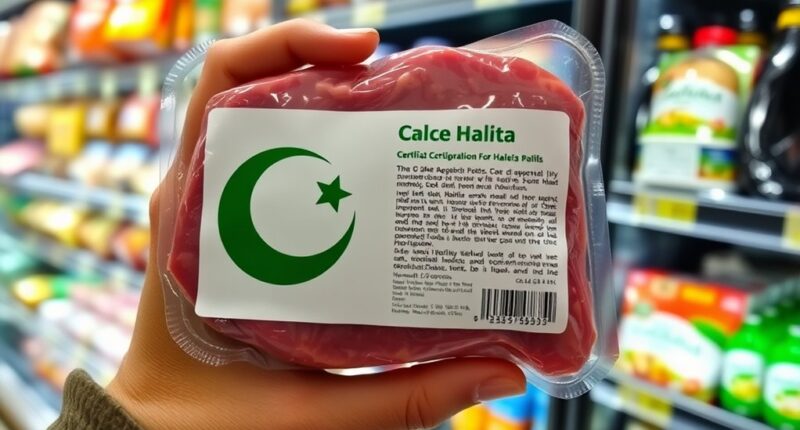To determine if food is halal, look for certification symbols from reputable halal authorities on packaging. Carefully check ingredient lists for forbidden components like pork derivatives, gelatin from non-halal sources, or alcohol. Be cautious of cross-contamination warnings and hidden additives. Familiarize yourself with common halal symbols and understand ingredient names that may indicate non-halal items. If you keep these tips in mind, you’ll be better equipped to identify halal options every time you shop.
Key Takeaways
- Look for reputable halal certification logos on packaging for quick verification.
- Read ingredient lists carefully to identify forbidden substances like pork derivatives or non-halal gelatin.
- Check for clear labels indicating halal status and avoid vague or unverified claims.
- Be aware of terms like “ethyl alcohol” or “alcohol” that may indicate non-halal ingredients.
- Confirm no cross-contact or shared equipment risks are mentioned on packaging or store signage.
Understanding Halal Certification Symbols

Understanding halal certification symbols is essential because they serve as clear indicators that a product meets Islamic dietary laws. These symbols help you quickly identify if food aligns with halal standards by following specific food certification processes. Halal dietary guidelines specify what ingredients and preparation methods are permissible, and certification guarantees these rules are met. When you see a recognized halal symbol on packaging, it confirms that the product has been inspected and approved by an authorized certifying body. This provides peace of mind, especially when shopping in unfamiliar stores or countries. By understanding these symbols, you can confidently select foods that adhere to your religious practices without needing to examine every ingredient list in detail.
Recognizing Common Forbidden Ingredients
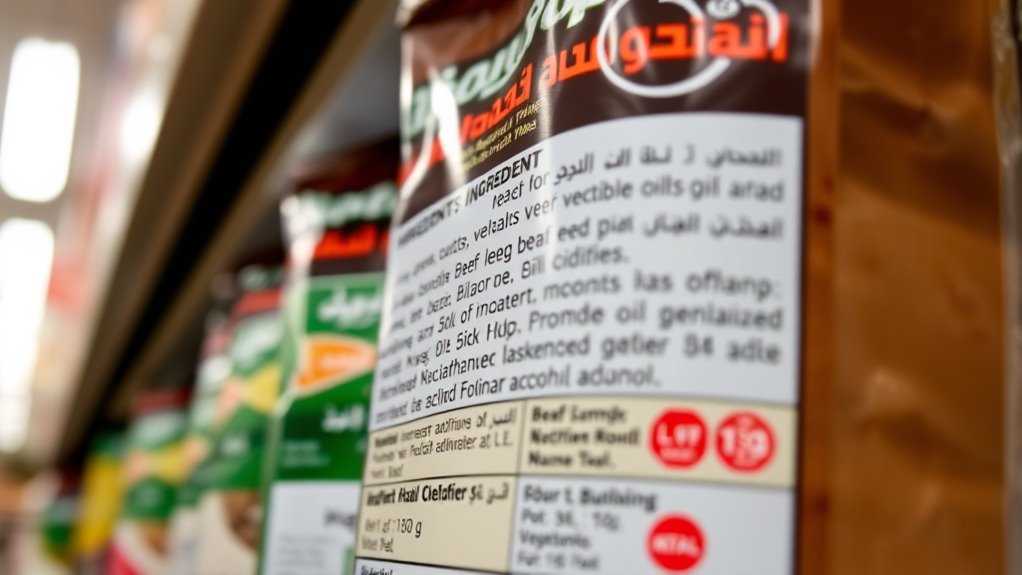
Many ingredients are considered forbidden in halal food, so it’s important to recognize them to guarantee your meals meet Islamic dietary laws. One common concern is pork derivatives, which can appear under various names like lard, pork fat, or enzymes derived from pigs. These additives are often hidden in processed foods, so always check ingredient lists carefully. Understanding ingredient labels is crucial for identifying these hidden components. A thorough knowledge of ingredient labeling can help you spot non-halal ingredients more effectively. Gelatin sources are another key ingredient to watch out for; gelatin derived from non-halal animals, especially pigs, is forbidden. Look for labels that specify “halal gelatin” or plant-based alternatives. By staying alert to these common forbidden ingredients, you can make informed choices and ensure your food complies with halal standards. Recognizing pork derivatives and gelatin sources helps you avoid inadvertently consuming non-halal components. Additionally, understanding how to read food labels can further aid in identifying hidden non-halal ingredients, including hidden additives or processing methods. Being familiar with certification symbols can also assist in quickly verifying the halal status of products.
Reading Labels for Animal-Derived Components
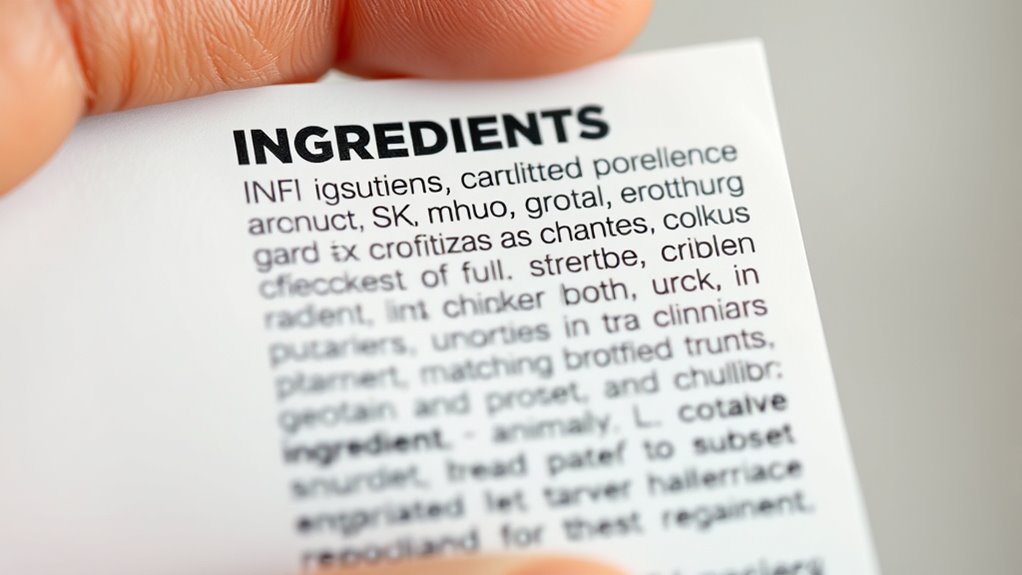
To guarantee your food is truly halal, you need to carefully read ingredient labels for animal-derived components. Proper ingredient identification helps you spot animal based ingredients that may not be obvious. Look for terms such as:
Carefully reading ingredient labels ensures your food remains genuinely halal and free from hidden animal derivatives.
- Gelatin
- Lard or pork fat
- Animal enzymes
- Cochineal or carmine
- Fish oil or fish sauce
These ingredients often appear under different names, so understanding common synonyms is essential. Always check the detailed ingredient list, especially in processed foods. Be aware that some additives and preservatives may contain animal derivatives. When in doubt, consult trusted halal certification symbols or contact manufacturers. Accurate ingredient identification ensures you avoid forbidden animal based ingredients and maintain your dietary standards. Reading labels carefully is key to making halal-conscious choices every time. Understanding ingredient labels can greatly assist in identifying hidden animal-derived components and ensuring compliance with halal dietary laws. Additionally, staying informed about alternative ingredients can help you make better choices when reading labels. Recognizing product certifications can also provide additional assurance of a product’s halal status. Being aware of labeling practices helps consumers better interpret ingredient lists and certifications.
Identifying Alcohol and Its Presence in Food Products

When checking ingredient labels for animal-derived components, it’s also important to look out for alcohol, which can be present in various food products. Alcohol detection is key because many items may contain alcohol as a preservative, flavoring, or processing agent. Look for terms like “ethyl alcohol,” “ethanol,” or “alcohol” in the ingredients list. Even small amounts can impact whether a product is halal. Pay attention to the ingredient alcohol content, as some foods may contain trace amounts that might not be obvious. If the label doesn’t specify the alcohol content or ingredient alcohol presence, consider researching the product or contacting the manufacturer for clarification. Being vigilant ensures you accurately identify halal-compliant foods free from alcohol. Additionally, understanding headphone connection types can help ensure proper use of audio devices when seeking information or clarification about food products. Recognizing the various labeling regulations can also assist in verifying the accuracy of ingredient disclosures. Being aware of durability and safety standards in packaging can help determine the integrity and authenticity of the product information provided. Furthermore, some food packaging may include certification marks that indicate adherence to halal standards, which can serve as an additional verification. Awareness of gaslighting tactics used in marketing or packaging claims can help consumers identify misleading information about ingredients.
Checking for Cross-Contamination Warnings

Always check for cross-contamination labels on packaging or menus, as they warn you about potential risks. Understanding shared equipment risks helps you avoid foods that may have come into contact with non-halal items. Being vigilant about these warnings guarantees your food stays true to your halal standards. Additionally, recognizing signs of spoilage in food labels or contents ensures you do not consume compromised products. Familiarity with trustworthy brands can also help you select safer options. Practicing mindful label reading promotes healthier and more ethical food choices. Being aware of certification symbols further assists in confirming the halal status of products. Keeping informed about food safety standards enhances your ability to make confident and compliant choices.
Look for Cross-Contamination Labels
Look for cross-contamination labels on packaging or in-store signage, as these warnings can help you identify whether the food has come into contact with non-halal products or utensils. These labels play a key role in ensuring ingredient safety and preventing accidental consumption of non-halal items. When checking labels, pay attention to specific phrases or symbols indicating cross-contamination risks. Additionally, being aware of farm animal handling practices can help you better understand how food is processed and whether it aligns with halal standards. Recognizing processing methods can further assist in identifying foods that meet halal criteria. Being familiar with cookie policies related to food labeling can also provide insights into how ingredient information is presented and verified. Understanding food safety guidelines can help you make more informed choices regarding ingredient sources and processing techniques. Moreover, awareness of fraud detection techniques used in food certification processes can help ensure the authenticity of halal labels and prevent fraudulent claims.
Understand Shared Equipment Risks
Sharing equipment between halal and non-halal foods can lead to cross-contact, so it’s vital to look for warnings on packaging or signage. Shared equipment, like grills, utensils, or processing machines, can transfer non-halal residues onto halal foods if not properly cleaned. Always check for labels or notices indicating whether the product was made on shared equipment. If you’re dining out, ask staff if their kitchen uses shared equipment and how they prevent cross-contact. Even a small amount of non-halal residue can compromise the halal status of your food. Being vigilant about shared equipment risks helps ensure your meal remains compliant with halal standards and reduces the chance of accidental contamination. When in doubt, seek clarification to protect your dietary requirements. Additionally, understanding self-awareness can help you better recognize and communicate your concerns about food preparation practices.
Understanding Ingredient Lists and Their Order

You should always check the ingredient list to understand what’s in your food. The order shows how much of each ingredient is present, with the largest amounts listed first. Look for halal components and be cautious of any non-halal ingredients that may be present.
Ingredient Listing Hierarchy
Have you ever wondered why ingredient lists are arranged in a specific order? It all comes down to understanding the ingredient hierarchy within the label structure. The ingredients are listed from highest to lowest quantity, giving you a clear picture of what’s most prominent in the product. This hierarchy helps you identify if any non-halal components are present in significant amounts. Keep in mind:
- The first few ingredients make up most of the product
- Smaller amounts appear toward the end
- Certain additives may be listed separately
- The order reflects the ingredient weight
- Recognizing this hierarchy aids in halal verification
Knowing how to interpret the ingredient hierarchy enables you to make informed choices quickly, ensuring the food aligns with halal standards.
Recognizing Halal Components
How can you quickly identify whether a food product contains halal ingredients just by reading the label? Focus on the ingredient list, which should clearly specify halal components and avoid non-halal items like alcohol or pork derivatives. Recognizing halal components involves checking for certifying symbols or labels from trusted halal authorities. Familiarize yourself with common halal ingredients such as halal meat, plant-based proteins, and permissible additives. Remember, halal food preparation adheres to specific guidelines, so avoid products with ambiguous or suspicious ingredients. By understanding ingredient lists and their order, you can confidently select products that comply with halal dietary guidelines. This simple step ensures your food aligns with your faith and maintains the integrity of your halal lifestyle.
Differentiating Between Halal and Haram Additives
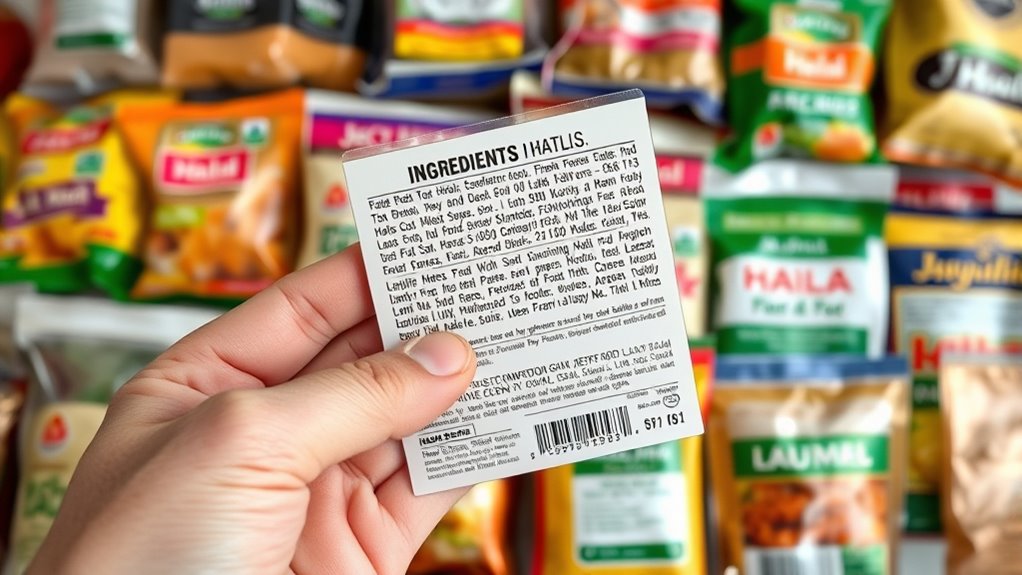
Distinguishing between halal and haram additives requires careful attention to ingredient lists and sourcing. You should look for halal certification on packaging to ensure additives meet Islamic dietary standards. Be cautious of forbidden additives, which are often derived from pig, alcohol, or improperly slaughtered animals. To help identify halal-friendly products, check for:
- Clear labeling indicating halal compliance
- Absence of alcohol-based flavorings
- No pig-derived ingredients
- Recognized halal-certified additives
- Avoidance of ambiguous terms like “natural flavor” without clarification
Recognizing Halal-Friendly Food Processing Labels
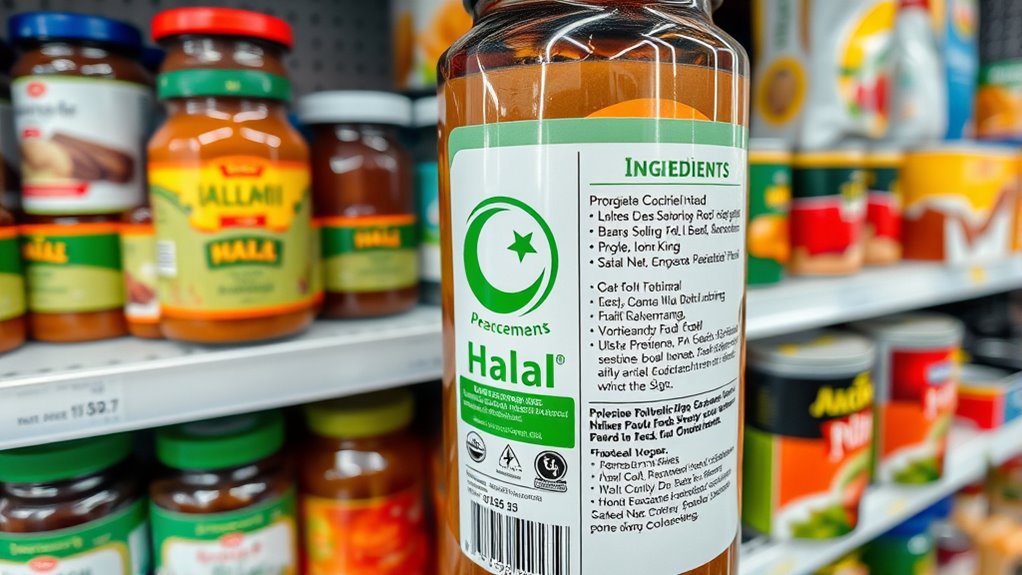
Recognizing halal-friendly food processing labels is essential for ensuring that products align with Islamic dietary laws. When examining packaging, look for certification labels from reputable halal authorities, which indicate proper halal food processing. Certification label interpretation involves understanding symbols or logos that verify the product’s compliance with halal standards. These labels often feature specific symbols, words like “Halal,” or accreditation marks from recognized organizations. Be cautious of vague claims or labels without clear certification. Additionally, familiarize yourself with the certifying organizations’ logos to quickly identify legitimate halal products. Proper recognition of these labels helps prevent accidental consumption of non-halal ingredients and ensures your food choices meet religious requirements. Always verify certification details if you’re uncertain about a product’s halal status.
Verifying the Source of Meat and Animal Products

To guarantee your meat is truly halal, start by checking for reliable source certification labels. You should also look for transparency about where the meat comes from and how it was produced. Verifying slaughtering practices is essential to confirm they align with halal standards.
Source Certification Labels
When verifying if meat and animal products are halal, checking for source certification labels is essential. These labels provide visual proof of halal certification and ingredient transparency, guaranteeing the product meets Islamic dietary standards. Look for official halal logos from reputable certifying bodies, which confirm the product’s compliance. Keep in mind that certification labels can vary by country, so familiarity with recognized symbols helps. Additionally, verify that the label indicates the source’s adherence to halal slaughter practices. Always double-check the certifying authority to avoid counterfeit labels. By prioritizing source certification labels, you ensure your food is genuinely halal and aligns with your dietary needs. This step helps you confidently select products that meet religious guidelines and maintain ingredient transparency.
Meat Origin Transparency
Knowing the origin of meat and animal products is crucial to guarantee they meet halal standards. You should always verify the meat origin to confirm it comes from a halal-certified animal source. Labels often specify the country of origin or the farm where the animal was raised, giving you insight into its background. If the label doesn’t clearly state the animal source, ask the retailer or supplier for clarification. Transparency about meat origin helps you avoid products from animals that weren’t slaughtered according to halal practices. Be cautious of vague labels like “meat” or “animal product” without further details. By confirming the source, you ensure the meat aligns with halal requirements and supports your commitment to consuming permissible foods.
Slaughtering Practices Verification
Verifying slaughtering practices is essential to guarantee the meat you consume meets halal standards. Halal slaughter methods involve specific procedures that ensure the animal is treated ethically and slaughtered according to Islamic law. To confirm proper slaughtering practices, look for certification from reputable halal authorities. You should also verify that the process includes these key points:
- The animal is slaughtered by a Muslim who understands halal requirements
- A swift, humane cut is made to minimize suffering
- The name of Allah is invoked during slaughter
- The animal is healthy and alive at the time of slaughter
- No prohibited substances or methods are used during slaughtering
Tips for Shopping at Halal Markets and Supermarkets

Are you unsure how to navigate halal markets and supermarkets effectively? To shop confidently, always check for clear halal labels on products like snacks and beverages. Look for certifications from trusted halal authorities to ensure authenticity. When browsing, read ingredient lists carefully, especially for processed items like Halal snacks and Halal beverages, to confirm they contain no forbidden ingredients. Don’t hesitate to ask staff if you’re uncertain about a product’s halal status. Keep an eye out for designated halal sections, which make shopping easier. Fresh produce is usually safe, but double-check packaging for any non-halal additives or cross-contamination risks. By being attentive and asking questions, you can shop efficiently and confidently while respecting your dietary requirements.
Frequently Asked Questions
How Can I Verify the Authenticity of Halal Certification Symbols?
You want to verify the authenticity of halal certification symbols, so start with certification verification. Check if the certification is issued by a reputable, recognized halal authority. Look for official logos and ensure they’re clear and not altered. You can also visit the certifying organization’s website to confirm the certification details. Doing this helps you confidently identify genuine halal certification, guaranteeing the food meets halal standards.
Are Vegetarian or Plant-Based Products Automatically Halal?
Even in the age of instant messaging, misconceptions about vegetarian or plant-based products being automatically halal still persist. You should not assume they’re halal just because they’re labeled “vegetarian” or “plant-based,” as some ingredients or processing methods might not meet halal standards. Always check the ingredients list and look for halal certification symbols, because plant-based labeling doesn’t necessarily guarantee the food’s compliance with halal requirements.
What Are Hidden Sources of Non-Halal Ingredients in Processed Foods?
You should be aware that hidden sources of non-halal ingredients can lurk in processed foods. Look out for hidden preservatives that might not be obvious, and animal-derived emulsifiers, which are often used in creamy or processed products. These ingredients are sometimes listed under generic names or additives, so it’s essential to read labels carefully and research unfamiliar terms to guarantee your food remains halal.
How Do I Identify Halal-Friendly Labels on Packaged Foods?
To identify halal-friendly labels on packaged foods, look for clear halal certification symbols from reputable authorities. These certifications guarantee the product meets halal standards. Also, carefully read ingredient labeling for any doubtful ingredients like alcohol or pork derivatives. If the label doesn’t specify halal certification or lists questionable ingredients, it’s safer to choose another product. Always trust products with recognized halal certification to ensure compliance with dietary requirements.
Can Certain Additives Be Halal Even if They Are Synthetically Produced?
You might wonder if certain additives are halal, even if they’re synthetically produced. Generally, synthetic ingredients can be halal if they’re free from forbidden substances and produced with additive safety in mind. Always check for trustworthy certifications and ingredient details. If you’re unsure about a synthetic additive, research its source or consult reliable halal authorities. This way, you guarantee your food aligns with your dietary and religious preferences.
Conclusion
Think of steering food labels like sailing a ship through calm waters. With sharp eyes and knowledge of Halal symbols and ingredients, you steer confidently away from forbidden islands. Trust your compass—your understanding of labels—and enjoy a smooth journey to wholesome, Halal-friendly meals. When you’re aware and attentive, you become the captain of your health and faith, guiding your ship safely to nourishing shores every time you shop.
